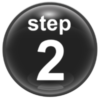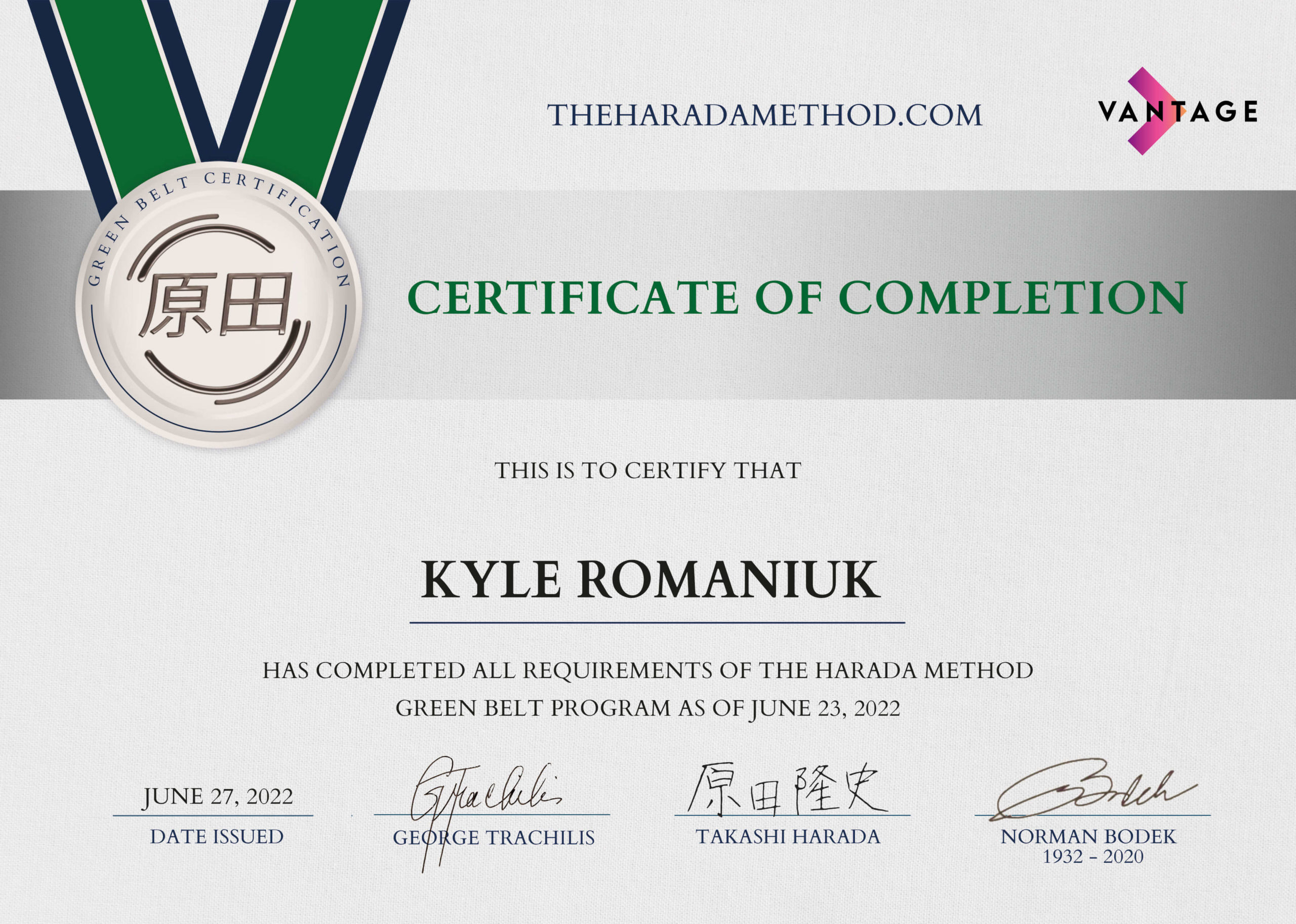Follow Us :
About The Harada Method
Takashi Harada’s System – The People side of Lean
The proven system towards self-reliance and the use of a coach. An employee-alignment masterpiece - discover it now.
“The reasons why people cannot achieve their goals are not because they lack abilities or character, but because they are setting their goals in a wrong way and trying to achieve them in a wrong way."

George Trachilis, The Lean Guru
I am amazed at what I was able to accomplish in just a few short years.
My one barrier was that I did not want to spend the money to invest in myself and my future. I am so glad I did.
The purpose of this course is to:
- Teach managers to become Leaders and Coaches
- Know how to pick successful goals
- Create a vision for long-term personal success
- Learn and understand how to communicate better within your organization
- Learn how to be an independent person and achieve personal and corporate goals
- Know how to make decision to benefit your organization, your customers and yourself
- Help people develop their talents to their fullest
- Learn how to lead and motivate people to become high achievers
- Raise your self-esteem to help you achieve your vision
- Improve your goal-setting technique
- Practice setting both long-term and short-term goals and objectives
- Create a successful future

Norman Bodek, the Godfather of Lean
Several years ago, I was introduced to “Day-to-Day Management“– a planning and organizational methodology created by Takashi Harada. It was claimed to be the world’s best process to develop people to their fullest capability. At first, I was both skeptical and fascinated, but I allowed my curiosity to guide me to discover more about the truth. After meeting Mr. Harada several times, taking a number of his courses in Japan, reading hundreds of translated pages about his work, teaching this methodology to my students at Portland State University, and training and certifying managers, executives and consultants; I am thoroughly convinced of the power of Mr. Harada’s work. I hope as you read this book you will agree that his technique is a “jewel“ and ranks with the work of Deming, Ohno, Shingo, and other giants of management.
The Harada Method takes lessons from highly successful, field-tested athletics programs and applies them to your life both on and off the job. I believe we all love a winner, but most of us have not been taught how to become one. In this book, we give you the steps to follow to transform yourself, and to create a new and very exciting life.

In this book, it is our intention to give you an introduction to the world’s best management training method to teach you how to have a very successful life.
It was my miracle to have discovered Takashi Harada, and I now have the privilege to teach his work and to co-author this book. There are many “success” teachers in the world who have written bestselling books: Stephen R. Covey, Malcolm Gladwell, Jack Caldwell, and others, but in my opinion only Takashi Harada really gives you a step-by-step exact method to follow to reach your goals and your personal success. This book is about that method. If you follow the Harada Method you will find your personal and professional success. Let’s get started now, looking at what the Harada Method is and how you and your employees can get started learning the steps right away.

George Trachilis, Global Harada Coach & Lean Guru
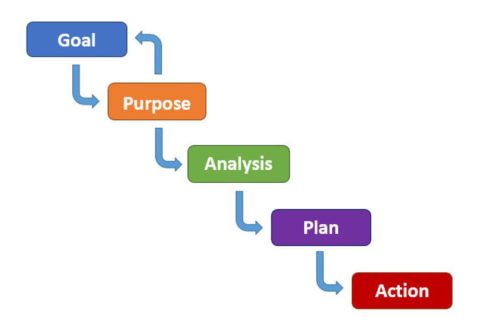
The Harada Method Overview - The Five Stages
- 1. Goal – set your direction with a specific, achievable objective. Working your values and goal into each other is a recursive process.
- 2. Purpose – connecting your values with your goals will help with selecting a goal that is heartfelt will bring your driving purpose in achieving the goal to the forefront of your consciousness.
- 3. Analysis – look at your past successes and failures to reinforce your strengths and eliminate your weaknesses, and note your perceived obstacles and state ways to overcome them.
- 4. Plan – build an action plan. You will stretch your imagination and list 64 tasks to accomplish your goal.
- 5. Action – incorporate your plan into your daily life, make yourself accountable for your actions, and sustain your efforts.
The Harada Method Five Forms
The Harada Method is a system that provides you a framework for reaching your goals and achieving success.
The Five Forms are:
You will need working copies of these forms as you go through the book. You get soft copies of the forms by registering for our white belt program.
Pricing Package
Our standard consulting rate is 3,000 USD per day. But times are changing. During these unique times our consultants have found that spending more time with family is worth taking a pay reduction. Our certification courses are available at a small fraction of what it would cost for on-site development. For teams of eight or more going through the learning we are currently giving a twenty-five percent discount on our certification prices.
The Harada Method Twenty Steps
We can further break down the five main stages into 20 basic steps of the Harada Method. They are not necessarily complicated, but they do require you to put in the effort and to do them diligently. The steps are:
Step 1 - Believe in Yourself It is vital for you to believe that you can and will be successful in both your personal and professional life. Understanding how the Harada Method has worked for others will give you confidence that you can indeed reach your goals.
Step 2 - Become Self-Reliant As we mentioned before, the Harada Method is based on the idea of self-reliance. Throughout this book you will see the terms self-reliant, self-directed, self-realized, self-determined and autonomous used interchangeably, all meaning having the ability to “stand on your own two feet,” - to have the confidence and the skills to reach your personal and professional goals. No matter what is happening in the world around you - an economic recession , political turmoil, etc. - you should put your energy into what you can do to improve your life and the lives of others around you. If you can get passionate about something and develop a deep knowledge of a subject, you will become self-reliant-possessing the wisdom to know how to use that skill for the betterment of society and yourself.
Step 3 - Determine the Key Service to Others It took me some time to understand Harada’s principle of making service to others an important part of attaining success. In America, we come from a culture that fosters the individual to succeed on his or her own. We are “rugged individualists,” coming from the Wild West mentality. Sure, we give to charity and are good to our families and friends, but we are taught to be fiercely competitive in the world of business. Being fiercely competitive is fine, but you should also include others in your ambition. Further on in the book, Mr. Harada will show you how serving others is an important key to your own success.
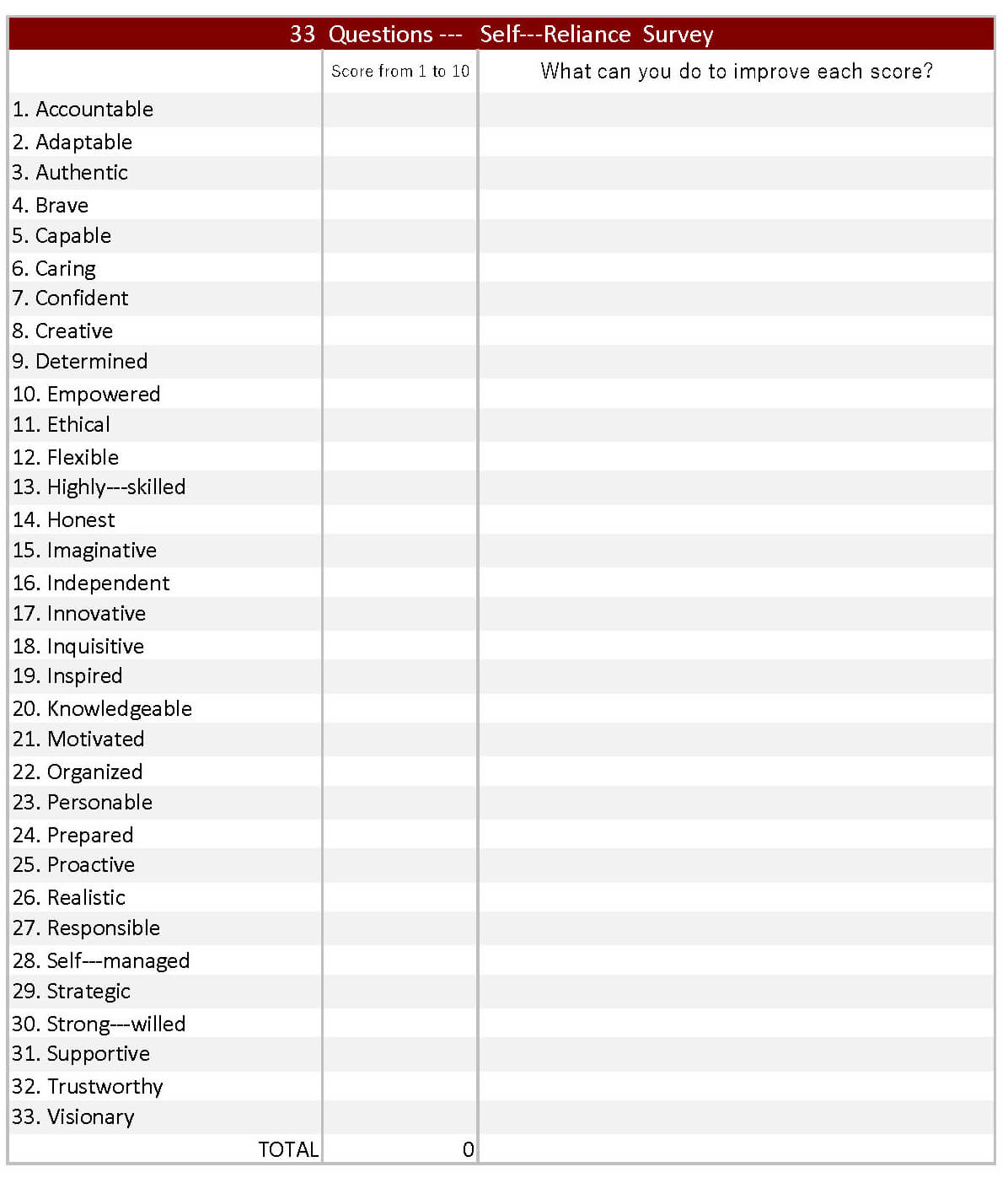
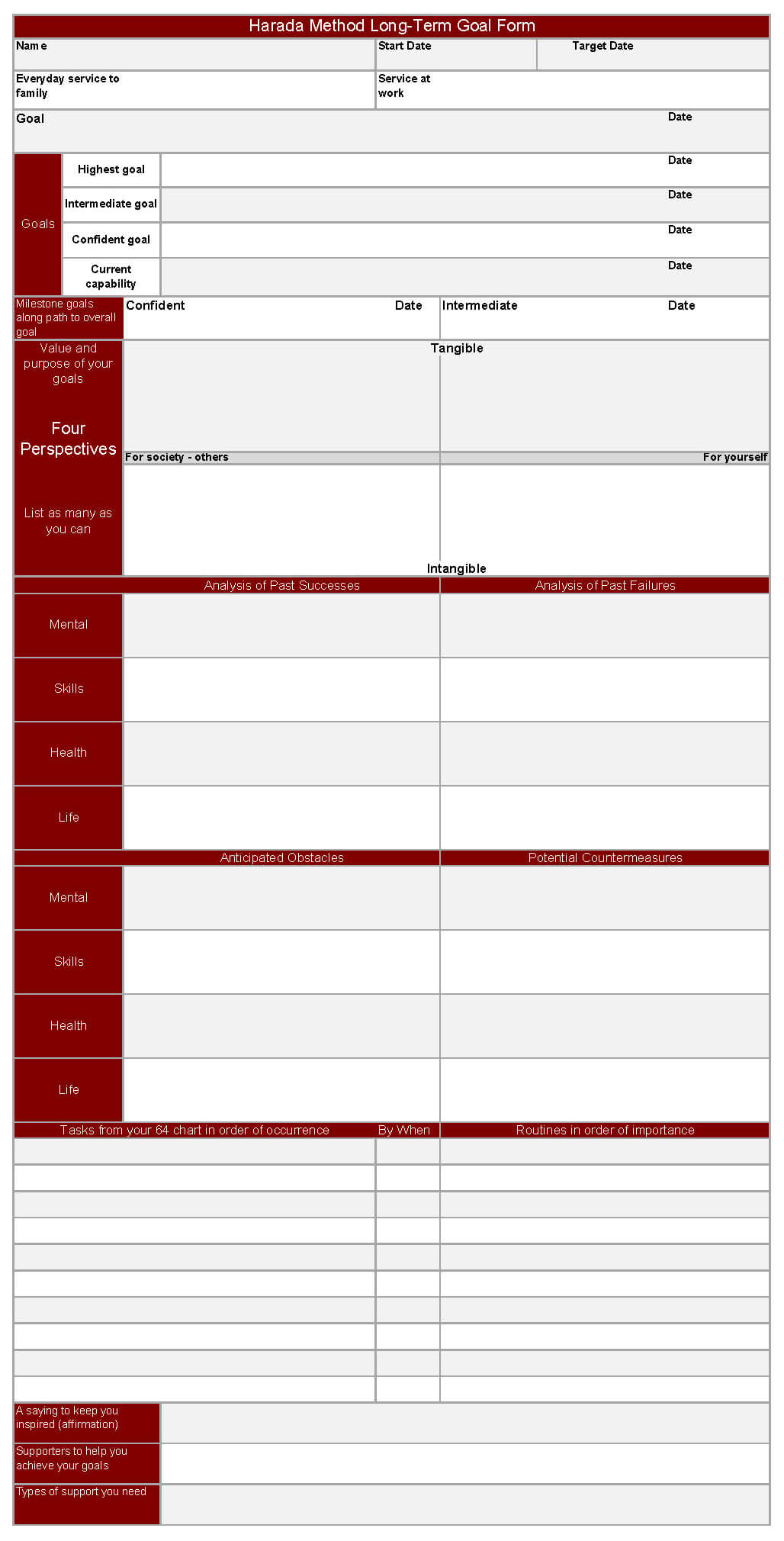
Step 4 - The Long-Term Goal Setting - Select Your Main Goal To move the process forward, you need to select a goal to be successful in life. You decide what you want to do. It is not easy to pick a goal, but you can do it. When I was young, I studied to be an accountant because my father and brother were accountants. I was not sure what I wanted to do. Fortunately, I found a new goal for my life and left accounting just three years after graduating from college, eventually becoming a publisher, writer, teacher and lecturer – a more fulfilling career for me.
Step 5 - Setting Different Goal Levels In the Harada Method you will set four kinds of goals: highest goal, intermediate or moderate goal, confident or easiest goal and what you think you can do with your current capability. When you have a series of goals, you are preparing to stretch yourself. It is not always easy to leap from your current state to attaining your highest goal so we set interim goals. We want to set levels to strive for.
Step 6 - Set Milestone Goals It would be nice if we could reach all our goals at once, without getting lost in the process of pursuing them. However, we often get frustrated in the middle of pursuing a goal because we cannot see our progress. For some reason, we do not know what is right or wrong when we are in the middle of doing something. To overcome this, write down some measurable milestone goals between the time you start and your goal due date to help motivate you to stay on track.
Step 7 - State Your Purposes and Values Your goal has value for others and for yourself. The deeper the purpose and the more meaningful it is to you and to others, the easier it will be for you to attain your goal. An example of a purpose: “If I can attain my goal, I know my family will have a better life - my children can go to college. They are depending on me to succeed - so I will.” u want to start and complete each task.
Step 8 - Analyze Yourself We want you to repeat behaviors that led you to success in the past. To do this, think of your past successes and write them down. Then write down the reasons you succeeded, using the following categories: mental, skills, health/physical condition and life/living (we will explain the categories in more detail later in the book). Repeat the process for your past failures and challenges, except that this time write the behaviors you want to avoid repeating.
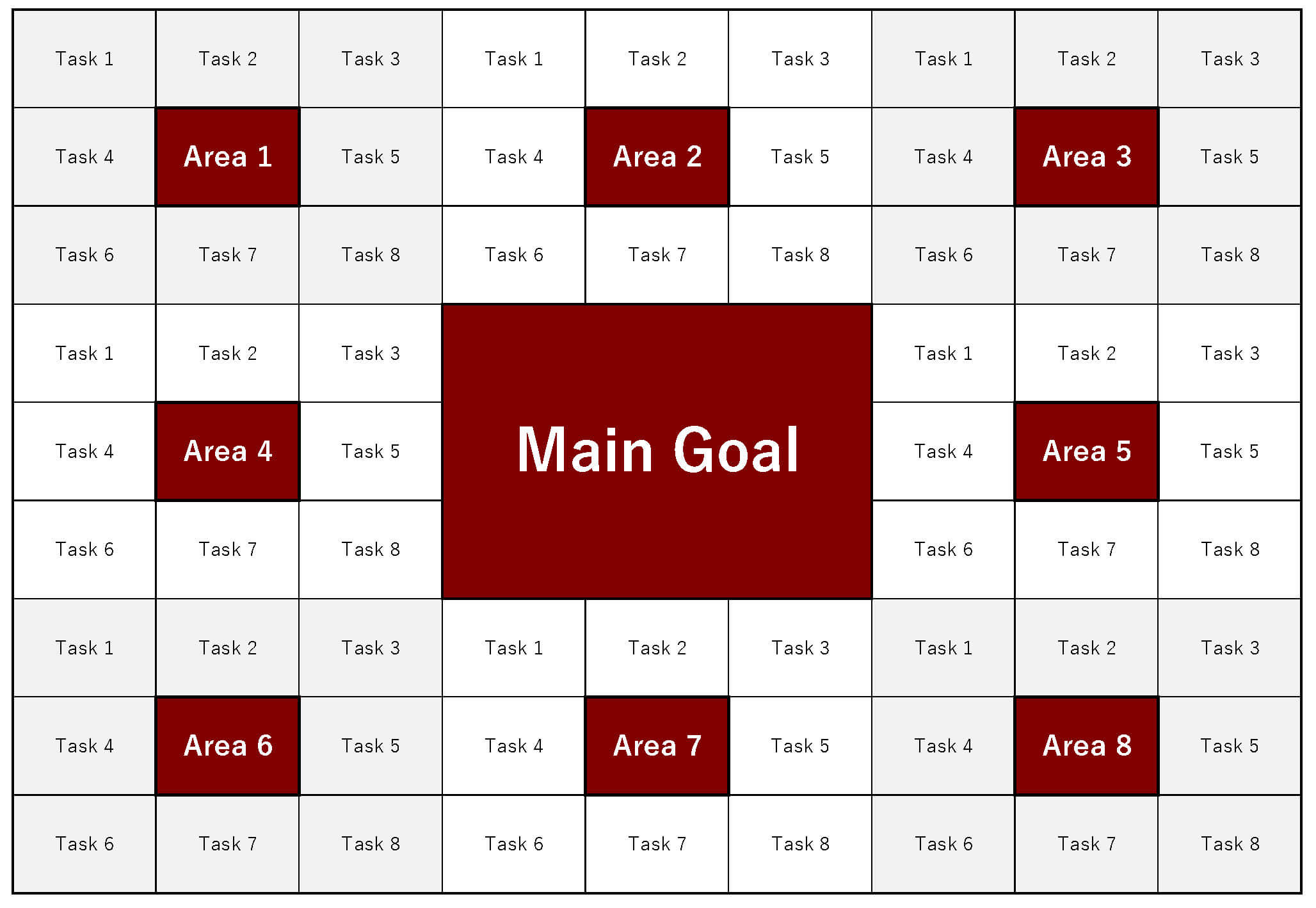
Step 9- Create Your 64-Chart with Eight Areas to Achieve Your Goal The 64-Chart is a matrix that helps you determine the tasks and actions you will need to take in the future to achieve your goals. You start by writing your main goal in the center box. Then you write down eight areas that will support your goal. If your goal is to be the “Best Harada Method Teacher,” for example, you might write down: Study, Marketing, Public Speaking, Teaching, Writing, etc. for your areas. We’ll get into greater detail on this chart in Chapter 9.
Step 10 - Write Eight Tasks for Each Area After coming up with the eight areas, you then write eight specific tasks within each area. For example, one of the eight areas in the example from Step 9 is “Study,” so you would write eight tasks, one in each box around the word Study. Some examples: “I want to read as much of Harada’s material as possible. This means I have to get his books translated into English.” “I want to read books and listen to videos done by great athletic coaches.” “I want to study and review the best training material on the subject.”
Step 11 - Write a Start Date for Each Task Once you have brainstormed 64 tasks, you need to reach your goals. You want to determine which ones to do first. Write down the date when you want to get started with each task. Do this for as many tasks as you can.
Step 12 - Select 10 Tasks to Get Started Go over your 64-Chart, look at the dates and prioritize the top ten tasks that you want to start doing immediately to attain your goal. Include the date when you want to start and complete each task.
Step 13 - New Routines Build New Habits On the Long-Term Goal Form, write 10 routines you want to do regularly to create positive habits and behaviors. The 10 routines can come from your 33 Self-reliant words, from your analysis section or from the 64-Chart. These routines will help you to build new patterns and behaviors.
Step 14 - Write Affirmations (Self-talk) Affirmations are statements that will keep your energy positive as you work towards achieving your goal. For example, this past winter I was watching the New York Knicks playing the Dallas Mavericks and with the outstanding performance of Jeremy Lin the Knicks won. Throughout the game, you could see the shouts of encouragement from one player to another. They huddle and cheer themselves to make them all believe they can win. The team uses certain chants to create the proper mindset for the game. You can do the same thing for yourself by writing affirmations.
Step 15 - Determine the Kind of Support You Need Think about the kinds of support you need to reach your goal. Will you need information? Advice? Coaching? Will you need someone to help you submit your new plan to your boss? Write down whatever types of support you think you might need to accomplish your goals.
Step 16 - Select People to Support You No one can be successful on their own. Even Tiger Woods, one of the world’s greatest golfers, always worked with a coach to observe his swings and body movement and help him improve his performance. Write down the names of people you can ask for help to reach your goal.
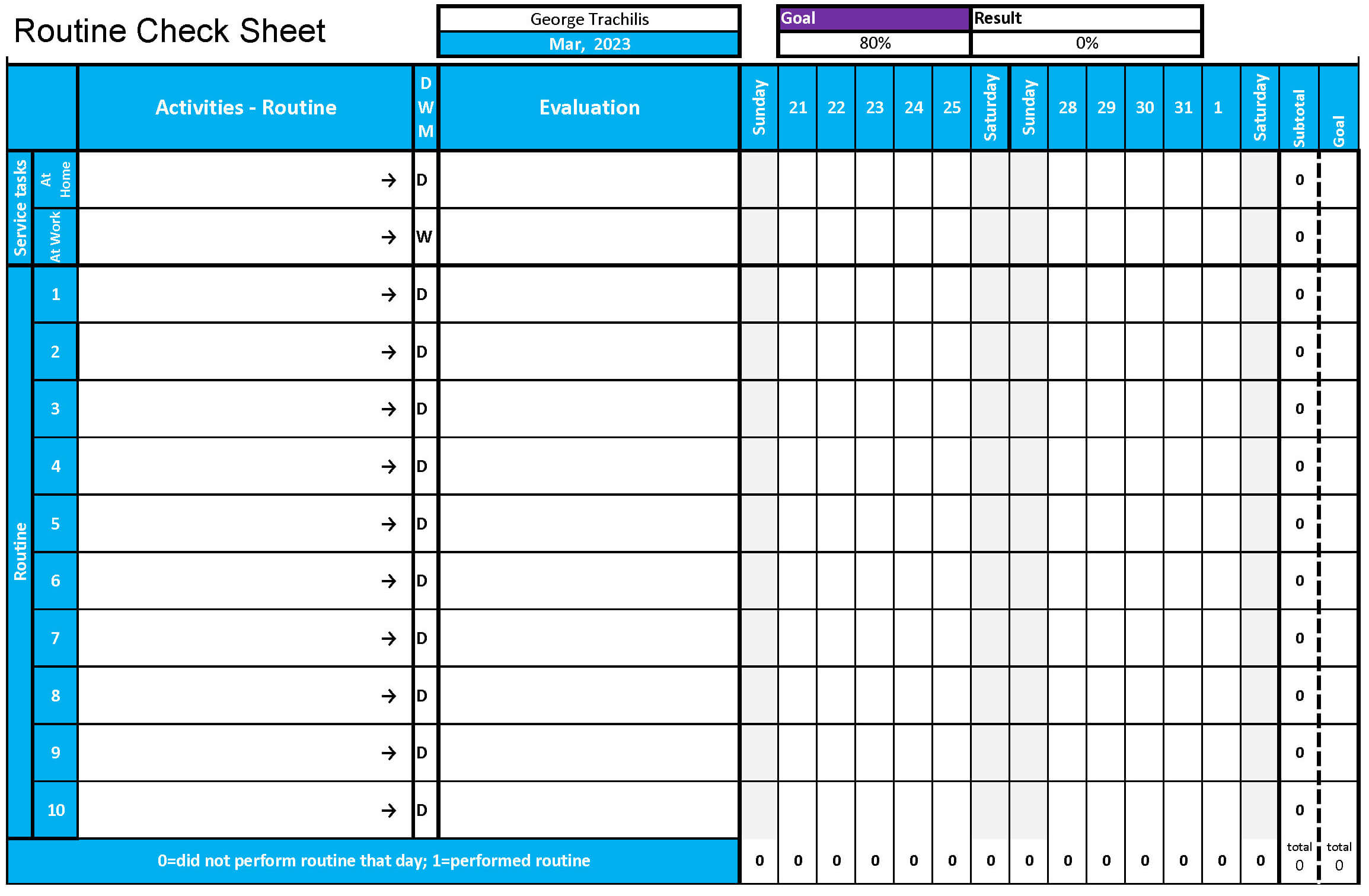
Step 17 - Use Your Routine Check Sheet Using the Routine Check Sheet every day, keep track of how many routines you did. You take the routines from the Long-Term Goal Setting and write them on the Routine Check Sheet. Here you will record every day your success in keeping your promises to yourself.
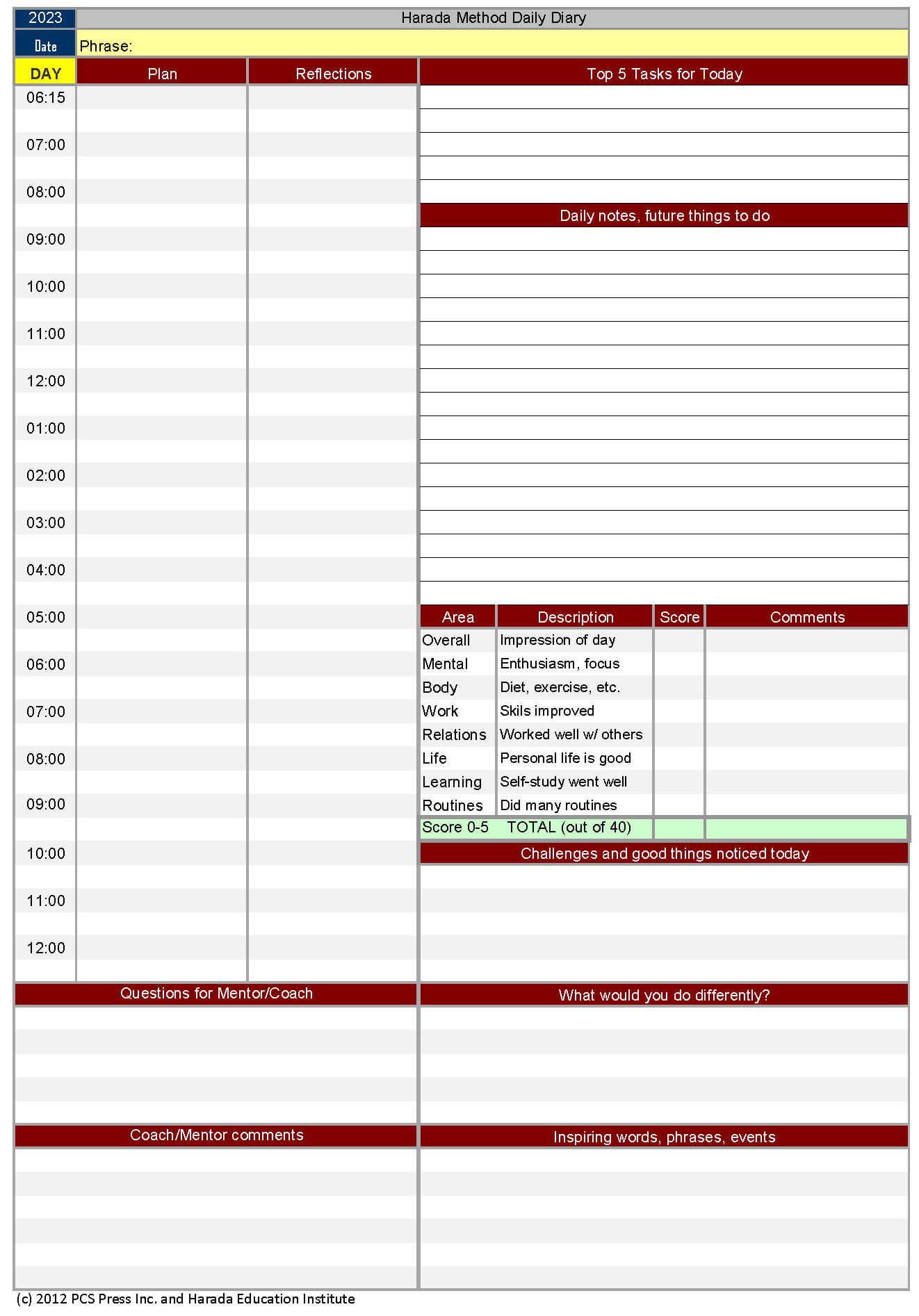
Step 18 - Keep a Daily Diary Use the Daily Diary to schedule your activities and to focus on the tasks and actions that need to be done to work closer to your goals. At the end of each day, use the diary to reflect on the challenges and successes that occurred throughout the day.
Step 19 - Work with a Coach/Mentor Meet with your coach/mentor as often as possible to review your Daily Diaries.
Step 20 - Revise Your Forms Monthly At the end of every month, look back at your Long-Term Goal Setting and your Routine Check Sheet and make any necessary revisions. If you have accomplished some of the tasks, replace them with new ones. If you would like to focus on new routines for the month, write them down too.

I know that the above list of steps might seem overwhelming, but don’t worry.
In the online course/book, we go through each step, one at a time, giving you specifics of what you need to do and how.
Remember, these steps took Harada many years to develop and he, and thousands of people, has experienced great success following the steps. It’s definitely worth the time and effort, and money if you invest in coaching.
I leave you with this thought. You should and could be the best in the world at something. It's your choice to commit. See Shohei Ohtani's open-window 64 chart below.
Book your first meeting at no cost.
Book your first meeting today. George’s service at work is to help future students engage with this excellent training. Self-develop on your own, or start using a coach. For a limited time, book a meeting with George. The first session is free with no obligation going forward. The least expensive way to engage in this training is to take the online course provided under courses.



